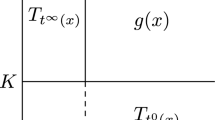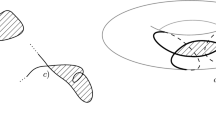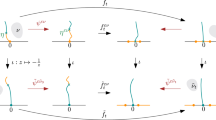Abstract
The problem of displacing a line with a definite point on it from one spatial position to another is studied by utilizing the concept of screw matrix. It is known that all the available finite twists (screws) associated with this displacement form a ruled surface, the so-called finite screw cylindroid. If the definition of the pitch given by Parkin is used, then the finite screw cylindroid can be regarded as a 2-system of screws. This brings to one's mind the question as to whether there exist different appropriate measures for pitch other than Parkin's under which all the available finite twists form a 2-system. This question is answered in this paper. By deriving a general expression of the pitch for these available finite twists under the said condition, it is shown that Parkin's pitch plus an arbitrary constant is the only possible measure of pitch under which the finite screw cylindroid represents a 2-system of screws. However, since adding a constant to the pitches of all screws of any 2-system still gives a 2-system, constant term may be omitted. It is also shown that the determined 2-system of screws can be described as a linear combination of two special basis screws which are called in this paper the α = 0 and the α = π screws.
Similar content being viewed by others
References
Hunt, K. H., Kinematic Geometry of Mechanisms. Claendon Press, Oxford 1978.
Huang, C. and Roth, B., 'Analytic expressions for the finite screw systems', Mech. Mach. Theory, 29(2) (1994), 207–222.
Beggs, J. S., Advanced Mechanisms, The Macmillan Company, New York Collier-Macmillan, London, 1965.
Parkin, I. A., 'A third conformation witht the screw systems: finite twist displacements of a directed line and point'. Mech. Mach. Theory, 27(2) (1992), 177–188.
Sticher, F., 'On the finite screw axis cylindroid', Mech. Mach. Theory, 24(3) (1989), 143–155.
Tsai, L. W. and Roth, B., Incompletely specified displacements: geometry and spatial linkage synthesis,' Trans. ASME Engng Ind. 95(B) (1973) 603–611.
Bottema, O. and Roth, B., Theoretical Kinematics, North-Holland, Amsterdam 1979.
Huang, C. and Chen, C., 'The linear representation of the screw triangle-a unification of finite and infinitesimal kinematics', ASME Journal of Mechanical Design, 117 December (1995).
Tokad, Y., 'A network model for rigid body motion', Dynamics and Control, 2 (1992) 59–82.
Frazer, R. A., Duncan, W. J. and Collar, A. R., Elementary Matrices, Cambridge University Press, 1963.
Argyris, J., in: FENOMECH'81, Proceedings of the 2nd International Conference on Finite Elements in Nonlinear Mechanics, August 25–28, 1981 Computer Methods in Applied Mechanics and Engineering, 32 (1982) 85–155.
Whittaker, E. T., Analytical Dynamics, Cambridge University Press, 1964.
Paul, R., Robot Manipulators: Mathematics, Programming, and Control. Cambridge, MIT Press, 1981.
Denavit, J. and Hartenberg, R. S., 'A kinematic notation for lower pair mechanisms based on matrices', Journal of Applied Mechanics, 22, Trans. ASME, June (1955), 215–221.
Author information
Authors and Affiliations
Rights and permissions
About this article
Cite this article
Ramahi, A., Tokad, Y. On the Finite Screw Cylindroid Represented as a 2-system of Screws. Meccanica 33, 111–125 (1998). https://doi.org/10.1023/A:1004315428961
Issue Date:
DOI: https://doi.org/10.1023/A:1004315428961




